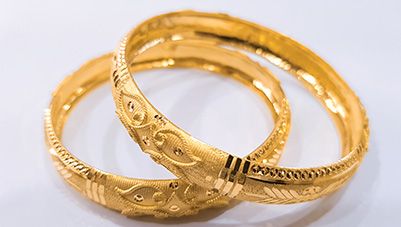Gold Price Trend for Next and Last 5 Years
Understanding gold price trend for next and last 5 years
Gold has always felt like that one reliable friend—steady, valuable, and there when you need it. Whether you are investing, planning a gold loan, or just curious about market trends, knowing how gold prices behave over time really helps.
In this guide, we will take a look at how gold prices have moved in the last five years and what experts say might happen in the next five. From global events to inflation and economic shifts, all these factors shape the journey of gold.
If you are thinking long-term—maybe saving for something big or planning to borrow against your gold—this insight into past trends and future forecasts can be incredibly helpful. You will also see how these trends might affect the loan-to-value ratio and overall gold loan terms.
Let us simplify the numbers and bring clarity to your gold-related decisions with this five-year gold price forecast.
Gold price trend over the last 5 years
Over the past five years, gold prices have shown significant volatility, influenced by various global economic factors.
- 2020: The COVID-19 pandemic triggered a surge in gold prices as investors sought safe-haven assets, peaking at over Rs. 148,000 per ounce in August.
- 2021: Despite a robust economic recovery, inflation concerns kept gold prices relatively high, fluctuating between Rs. 125,000 and Rs. 140,000 per ounce.
- 2022: Geopolitical tensions, particularly the Russia-Ukraine conflict, contributed to a spike in gold prices, reaching around Rs. 145,000 per ounce.
- 2023: The latest year trend showed that gold prices remained elevated despite stabilisation. Persistent inflation and global economic uncertainty kept the rates high throughout the year. The market reflected strong investor demand, with prices averaging at elevated levels per ounce across domestic and international markets.
- 2024: The gold price trend in 2024 is expected to continue being influenced by global economic recovery and ongoing inflationary pressures. Despite economic stabilization efforts, geopolitical tensions and fluctuating currency values could cause price fluctuations, with gold likely averaging around Rs. 140,000 to Rs. 150,000 per ounce.
- 2025: Gold prices in 2025 may see moderate fluctuations, as interest rates stabilise and inflationary pressures ease. With global economic recovery underway, gold prices may experience a steady yet cautious growth trajectory, potentially averaging between Rs. 145,000 and Rs. 155,000 per ounce, depending on market demand and geopolitical events.
Note: These INR values are approximate and based on the exchange rate of 1 USD = 74 INR. Adjustments may be necessary depending on the current exchange rate.
Predictions for gold prices over the next 5 years
| Year | Predicted Price Range (per ounce) |
| 2025 | Rs. 1,63,000 - Rs. 1,79,000 |
| 2026 | Rs. 1,67,000 - Rs. 1,83,000 |
| 2027 | Rs. 1,71,000 - Rs. 1,87,000 |
| 2028 | Rs. 1,75,000 - Rs. 1,91,000 |
| 2029 | Rs. 1,79,000 - Rs. 1,95,000 |
These predictions are based on current economic indicators, including inflation rates, geopolitical tensions, and monetary policies of major economies.
(Note: The conversion is based on an approximate exchange rate of $1 = Rs. 82. Please adjust according to the current exchange rate for more accurate figures.)
Analysing future gold market trends (2025-2030)
To understand what is the gold market price trend in the future, several factors need to be analysed:
- Economic policies: Central bank policies, especially those of the Federal Reserve, will play a significant role. Interest rate changes and quantitative easing measures can affect gold prices.
- Inflation: Persistent inflation concerns may drive up demand for gold as a hedge, pushing prices higher.
- Geopolitical stability: Ongoing geopolitical tensions and conflicts will likely sustain demand for gold as a safe-haven asset.
- Technological advances: Innovations in mining and gold recycling technologies could influence supply and, consequently, prices.
- Market sentiment: Investor behaviour, influenced by market volatility and economic forecasts, will impact gold prices.
By analysing these trends, stakeholders can make informed decisions regarding gold investments and loans.
Get a clear idea of your loan value by checking your gold loan eligibility. You can benefit from fast approval and convenient repayment options.
Projected gold price movements in the next 5 years and last 5 years
Let us explore the projected gold price trend in 5 years:
- Steady increase: Predicted gradual increase due to inflation and economic policies.
- Geopolitical impact: Potential spikes due to geopolitical instability.
- Technological influence: Changes in supply due to new mining technologies.
- Economic recovery: Slow but steady economic recovery supporting gold prices.
Let's take a closer look at the gold price trend over the last 5 years:
Over the past few years, the gold price trend has shown significant shifts, influenced by global and domestic factors.
2019–2020: Gold prices surged sharply due to trade tensions and the COVID-19 pandemic, as investors turned to gold as a safe-haven asset.
2021–2023: Prices witnessed heavy fluctuations driven by post-pandemic recovery, inflationary pressures, and geopolitical issues like the Russia-Ukraine conflict.
2024: The market saw relative stabilisation, though prices remained high due to inflation and uncertain global economic growth.
2025 (current year): Gold continues to hold strong, with high demand from both investors and consumers. Inflation concerns, central bank policies, and global tensions are expected to keep prices elevated.
Looking ahead, the gold price forecast suggests steady but elevated levels over the next few years. Investors should track these movements closely to make informed decisions.
Future gold prices and their effect on loan-to-value ratios
Future gold prices will significantly influence loan-to-value (LTV) ratios in gold loans. As gold prices rise, the value of the collateral increases, allowing borrowers to secure higher loan amounts. For instance, if the price of gold rises to ₹1,75,000 per 10 grams, the LTV ratio will improve, benefiting borrowers with more substantial loans.
However, lenders may adjust interest rates to mitigate the risks associated with price volatility. When gold prices are high, it also enhances the attractiveness of gold loans, making them a preferred choice during economic uncertainties. Borrowers should stay updated on gold price trends, including the gold rate today in India, to optimise their loan terms. Fluctuating gold rates can affect both the amount available for loan disbursement and the interest rates, making it essential to make informed decisions. Regular monitoring of the gold price forecast and understanding how these trends impact the LTV ratio will help borrowers plan their gold loan applications effectively, ensuring they get the best possible deal in line with market conditions.
Check your gold loan eligibility and leverage the value of your gold based on today’s rates.
Gold loan benefits and risks during economic uncertainty
Benefits of gold loan:
- Quick access: Gold loans provide fast access to funds, crucial during economic crises.
- Lower interest rates: Compared to personal loans, gold loans generally have lower interest rates.
- High LTV ratios: Rising gold prices can increase the loan amount you can secure.
- Flexibility: Multiple repayment options, including bullet repayment, make gold loans flexible.
Risks involved:
- Price volatility: Fluctuating gold prices can affect the collateral value.
- Repayment pressure: Inability to repay can lead to the loss of gold assets.
- Interest rate changes: Economic instability can lead to fluctuating interest rates, affecting loan affordability.
How does past gold price trends affect gold loan terms
Past gold price trends significantly influence current gold loan terms. High gold prices in the past five years have led to favourable loan terms, with higher loan amounts and lower interest rates.
For example, Bajaj Finserv Gold Loan offers competitive gold loan interest rates based on current and historical gold prices. Understanding past trends helps in negotiating better terms, as lenders use historical data to set today gold loan rate. Borrowers can leverage high past prices to secure better loan conditions, ensuring optimal use of their gold assets as collateral.
Discover your borrowing potential by checking your gold loan eligibility. It takes just a few clicks and no waiting.
Related Articles
Disclaimer
Bajaj Finance Limited has the sole and absolute discretion, without assigning any reason to accept or reject any application. Terms and conditions apply*.
For customer support, call Personal Loan IVR: 7757 000 000









 Personal Loan
Personal Loan Check Eligibility
Check Eligibility Salaried Personal Loan
Salaried Personal Loan EMI Calculator
EMI Calculator Account Aggregator
Account Aggregator Credit Pulse Report
Credit Pulse Report
 Deals starting @99
Deals starting @99 Min. 50% off
Min. 50% off
 Bajaj Pay
Bajaj Pay Wallet to Bank
Wallet to Bank
 Easy EMI Loan
Easy EMI Loan Savings Offer
Savings Offer Smartphones
Smartphones Led TVs
Led TVs Washing Machines
Washing Machines Laptops
Laptops Refrigerators
Refrigerators Air Conditioner
Air Conditioner Air Coolers
Air Coolers
 Loan Against Shares
Loan Against Shares Loan Against Mutual Funds
Loan Against Mutual Funds Loan Against Insurance Policy
Loan Against Insurance Policy ESOP Financing
ESOP Financing Easy EMI Loan
Easy EMI Loan Two-wheeler Loan
Two-wheeler Loan Loan for Lawyer
Loan for Lawyer Industrial Equipment Finance
Industrial Equipment Finance Industrial Equipment Balance Transfer
Industrial Equipment Balance Transfer Industrial Equipment Refinance
Industrial Equipment Refinance Personal Loan Branch Locator
Personal Loan Branch Locator Used Tractor Loan
Used Tractor Loan Loan Against Tractor
Loan Against Tractor Tractor Loan Balance Transfer
Tractor Loan Balance Transfer Flexi
Flexi View All
View All
 Two-wheeler Loan
Two-wheeler Loan Bike
Bike Scooter
Scooter Electric Vehicle
Electric Vehicle Best Sellers
Best Sellers Popular Brands
Popular Brands

 Trading Account
Trading Account Open Demat Account
Open Demat Account Margin Trading Financing
Margin Trading Financing Share Market
Share Market Invest in IPO
Invest in IPO All stocks
All stocks Top gainers
Top gainers Top losers
Top losers 52 week high
52 week high 52 week low
52 week low Loan against shares
Loan against shares
 Home Loan
Home Loan Transfer your existing Home loan
Transfer your existing Home loan Loan against Property
Loan against Property Home Loan for Salaried
Home Loan for Salaried Home loan for self employed
Home loan for self employed Loan Against Property Balance Transfer
Loan Against Property Balance Transfer Home Loan EMI Calculator
Home Loan EMI Calculator Home Loan eligibility calculator
Home Loan eligibility calculator Home Loan balance transfer
Home Loan balance transfer View All
View All
 Term Life Insurance
Term Life Insurance ULIP Plan
ULIP Plan Savings Plan
Savings Plan Family Insurance
Family Insurance Senior Citizen Health Insurance
Senior Citizen Health Insurance Critical Illness Insurance
Critical Illness Insurance Child Health Insurance
Child Health Insurance Pregnancy and Maternity Health Insurance
Pregnancy and Maternity Health Insurance Individual Health Insurance
Individual Health Insurance Low Income Health Insurance
Low Income Health Insurance Student Health Insurance
Student Health Insurance Group Health Insurance
Group Health Insurance Retirement Plans
Retirement Plans Child Plans
Child Plans Investment Plans
Investment Plans
 Business Loan
Business Loan Secured Business Loan
Secured Business Loan Loan against property
Loan against property Loans against property balance transfer
Loans against property balance transfer Loan against shares
Loan against shares Home Loan
Home Loan Loans against mutual funds
Loans against mutual funds Loan against bonds
Loan against bonds Loan against insurance policy
Loan against insurance policy
 Apply for Gold Loan
Apply for Gold Loan Transfer your Gold Loan with Us
Transfer your Gold Loan with Us Gold Loan Branch Locator
Gold Loan Branch Locator
 ULIP Plan
ULIP Plan Savings Plan
Savings Plan Retirement Plans
Retirement Plans Child Plans
Child Plans Free Demat Account
Free Demat Account Invest in Stocks
Invest in Stocks Invest in IPO
Invest in IPO Margin Trading Facility
Margin Trading Facility Fixed Deposit Branch Locator
Fixed Deposit Branch Locator
 Check your Credit Score
Check your Credit Score
 New Car Loan
New Car Loan Used Car Loan
Used Car Loan Loan Against Car
Loan Against Car Car Loan Balance Transfer and Top-up
Car Loan Balance Transfer and Top-up My Garage
My Garage
 Get Bajaj Prime
Get Bajaj Prime
 Mobiles on EMI
Mobiles on EMI Electronics on EMI Offer
Electronics on EMI Offer  Iphone on EMI
Iphone on EMI LED TV on EMI
LED TV on EMI Refrigerator on EMI
Refrigerator on EMI Laptop on EMI
Laptop on EMI Kitchen appliances on EMI
Kitchen appliances on EMI Washing machines
Washing machines
 Personal Loan EMI Calculator
Personal Loan EMI Calculator Personal Loan Eligibility Calculator
Personal Loan Eligibility Calculator Home Loan EMI Calculator
Home Loan EMI Calculator Home Loan Eligibility Calculator
Home Loan Eligibility Calculator Good & Service Tax (GST) Calculator
Good & Service Tax (GST) Calculator Flexi Day Wise Interest Calculator
Flexi Day Wise Interest Calculator Flexi Transaction Calculator
Flexi Transaction Calculator Secured Business Loan Eligibility Calculator
Secured Business Loan Eligibility Calculator Fixed Deposits Interest Calculator
Fixed Deposits Interest Calculator Two wheeler Loan EMI Calculator
Two wheeler Loan EMI Calculator New Car Loan EMI Calculator
New Car Loan EMI Calculator Used Car Loan EMI Calculator
Used Car Loan EMI Calculator All Calculator
All Calculator Used Tractor Loan EMI Calculator
Used Tractor Loan EMI Calculator
 Hot Deals
Hot Deals Clearance Sale
Clearance Sale Kitchen Appliances
Kitchen Appliances Tyres
Tyres Camera & Accessories
Camera & Accessories Mattresses
Mattresses Furniture
Furniture Watches
Watches Music & Audio
Music & Audio Cycles
Cycles Mixer & Grinder
Mixer & Grinder Luggage & Travel
Luggage & Travel Fitness Equipment
Fitness Equipment Fans
Fans
 Personal Loan for Doctors
Personal Loan for Doctors Business loan for Doctors
Business loan for Doctors Home Loan
Home Loan Secured Business Loan
Secured Business Loan Loan against property
Loan against property Secured Business Loan Balance Transfer
Secured Business Loan Balance Transfer Loan against share
Loan against share Gold Loan
Gold Loan Medical Equipment Finance
Medical Equipment Finance
 Smart Hub
Smart Hub ITR Service
ITR Service Digi Sarkar
Digi Sarkar
 Savings Offer
Savings Offer Easy EMI
Easy EMI Offer World
Offer World 1 EMI OFF
1 EMI OFF New Launches
New Launches Zero Down Payment
Zero Down Payment Clearance Sale
Clearance Sale Bajaj Mall Sale
Bajaj Mall Sale
 Mobiles under ₹20,000
Mobiles under ₹20,000 Mobiles under ₹25,000
Mobiles under ₹25,000 Mobiles under ₹30,000
Mobiles under ₹30,000 Mobiles under ₹35,000
Mobiles under ₹35,000 Mobiles under ₹40,000
Mobiles under ₹40,000 Mobiles under ₹50,000
Mobiles under ₹50,000
 Articles
Articles
 Overdue Payments
Overdue Payments Other Payments
Other Payments
 Document Center
Document Center Bank details & Documents
Bank details & Documents Tax Invoice Certificate
Tax Invoice Certificate
 Do Not Call Service
Do Not Call Service
 Hamara Mall Orders
Hamara Mall Orders

 Fixed Deposit (IFA) Partner
Fixed Deposit (IFA) Partner Loan (DSA) Partner
Loan (DSA) Partner Debt Management Partner
Debt Management Partner EMI Network Partner
EMI Network Partner Became a Merchant
Became a Merchant Partner Sign-in
Partner Sign-in
 Trade directly with your Demat A/c
Trade directly with your Demat A/c ITR
ITR My Garage
My Garage
 Live Videos - Beta
Live Videos - Beta
 Savings Offer
Savings Offer Smartphones
Smartphones LED TVs
LED TVs Washing Machines
Washing Machines Laptops
Laptops Refrigerators
Refrigerators Air Conditioners
Air Conditioners Air Coolers
Air Coolers Water Purifiers
Water Purifiers Tablets
Tablets Kitchen Appliances
Kitchen Appliances Mattresses
Mattresses Furniture
Furniture Music and Audio
Music and Audio Cameras & Accessories
Cameras & Accessories Cycle
Cycle Watches
Watches Tyres
Tyres Luggage & Travel
Luggage & Travel Fitness Equipment
Fitness Equipment Tractor
Tractor Easy EMI Loan
Easy EMI Loan
 vivo Mobiles
vivo Mobiles OPPO Mobiles
OPPO Mobiles Xiaomi Mobiles
Xiaomi Mobiles Sony LED TVs
Sony LED TVs Samsung LED TVs
Samsung LED TVs LG LED TVs
LG LED TVs Haier LED TVs
Haier LED TVs Godrej Refrigerators
Godrej Refrigerators Voltas Washing Machines
Voltas Washing Machines
 New Tractor Loan
New Tractor Loan Used Tractor Loan
Used Tractor Loan Loan Against Tractor
Loan Against Tractor Tractor Loan Balance Transfer
Tractor Loan Balance Transfer
 New Car Loan
New Car Loan New Cars Under ₹10 Lakh
New Cars Under ₹10 Lakh New Cars – ₹10–₹15 Lakh
New Cars – ₹10–₹15 Lakh New Cars – ₹15–₹20 Lakh
New Cars – ₹15–₹20 Lakh New Cars – ₹20–₹25 Lakh
New Cars – ₹20–₹25 Lakh New Car Brands
New Car Brands Petrol – New Cars
Petrol – New Cars Diesel – New Cars
Diesel – New Cars Electric – New Cars
Electric – New Cars CNG – New Cars
CNG – New Cars Hybrid – New Cars
Hybrid – New Cars






